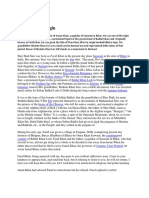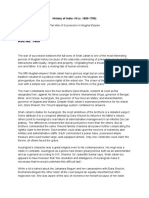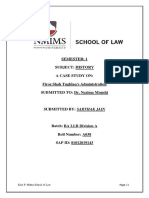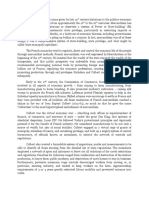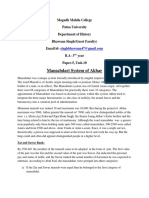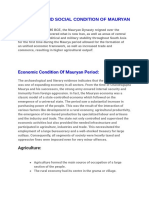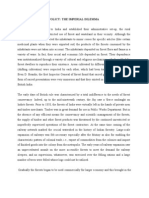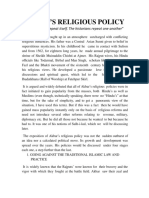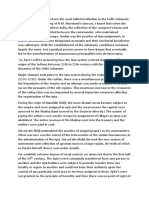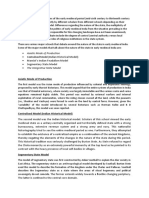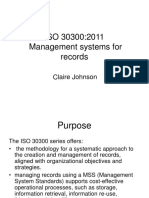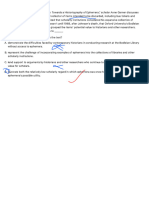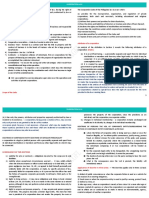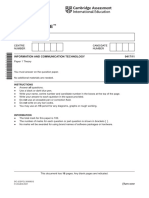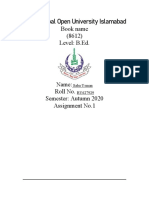Sher Shah and His Administration
Sher Shah ascended the throne of Delhi in 1540. As a ruler, Sher Shah ruled the
mightiest empire which had come into existence in north India since the time of
Muhammad Bin Tughlaq. His empire extended from Bengal to Indus, excluding
Kashmir. In the west, he conquered Malwa, and almost the entire Rajasthan. While
Mughals were engaged on the seacoast, Sher khan Sur had quietly gained control
of the military fief of his father in southern Bihar. In 1537, Sher Shah invaded
Bengal, and besieged him at Gaur, his capital. The Mughals and the Afghans met
once again at Chausa, after three months of inconclusive negotiations between the
Mughals and Sher Khan resulted in a surprise attack by the Afghans in June 1539.
After winning against the Mughal forces Sher Khan assumed the title of Sher Shah.
In May, 1540, the Mughal and Afghan armies met once again near Kanauj,
resulting in Humayun fleeing to Agra and then to Lahore with a few of his
followers. This left the Sher Shah as the unchallenged ruler of northern India in
1540.
Sher Shah is seen to have been responsible for the establishment of a fairly
comprehensive system of law and order: he made roads safer, taking action against
robbers and dacoits; he controlled recalcitrant zamindars (often allied with dacoits)
in areas like Lucknow and Moradabad. Muqaddams and zamindars were made
responsible for apprehending those responsible for crimes that fell within the
vicinity of their jurisdiction. It appears that, as exemplary punishment, failure to
track down (or produce) criminals led to the execution of the Muqaddam.
Sher Shah is widely credited with the massive improvement of roads and channels
of communication. The development of roads facilitated the movement of both
military forces and goods. The linkages between roads and commercial growth is
attested by the fact that Agra was deliberately linked up with roads leading up to
the sea-ports of Gujarat: in Burhanpur, Jodhpur and Chittor. He restored the old
imperial road called Grand Trunk road, from river Indua in the west to Sonargaon
in Bengal. The emperor also built sarais or rest-houses on every road, every four
miles. We are told that Sher Shah built 1700 sarais in all. His roads and serais have
�been called ‘ arteries of the empire’. They helped in quickening trade and
commerce in the country. The importance accorded mercantile activity is further
proved by the appointment of custodians or shehnas at these rest-houses,
specifically to look after the goods of merchants.
This links up with those administrative regulations of Sher Shah that pertained to
currency and trade: he struck new, fine coins of silver and copper of uniform
standard ( his silver coin remaining standard in the Mughal empire for a long time
), and made some attempts to standardized weights and measures. Officials of the
State were ordered to purchase goods from merchants at market price, though in
practice this regulation seems to have been frequently contravened ). Further, the
new rule that customs duties on goods were only to be paid at the place of entry
and the time of sale protected merchants from onerous and multiple dues.
Sher Shah’s reforms in the field of revenue administration are accorded much
importance by historians. Essentially, as Moreland points out, these boil down to
one substantial change: the institution of a system of measurement (came to be
called the zabt system ) in order to compute the average yield and to fix the tax.
Sher Shah rejected both crop-sharing (the practice generally preferred by peasants )
and estimation on the basis of sample-cuttings from the sown area. Sher Shah
insisted on measurement of the sown land. A crop rate was drawn up, laying down
state’s share of the different types of crops. The share of the state was one-third of
the produce. The lands were divided into good, middling and bad. The peasants
were given the option of paying in cash or kind, though the state preferred cash.
The areas sown, the types of crops cultivated, the amount each peasant had to pay
was written down on a paper called patta and each peasant was informed of it. No
one was allowed to charge extra from the peasants. In order to guard against
famine and other natural calamities, a cess at the rate of two and a half seer per
bigha was levied. Irfan Habib points out that this system was in practice only
applied to the doab, Punjab and Malwa, both the system of assessment and the
amount collected varying from region to region. I. A. Siddiqui argues that Sher
Shah, being a benevolent and `humanistic’ ruler, was concerned that peasants
shouldn’t be overburdened with State and local demand. However, it can also be
argued that the concern with the individual peasants also served to extend the
effective power of the State.
�Sher Shah set up a strong army in order to administer his vast empire. He recruited
soldiers directly after verifying their character. Every soldier has his descriptive
roll (chehra) recorded, and his horse branded with imperial sign so that the horses
of inferior quality may not be substituted. Sher Shah seems to have borrowed this
system, known as dagh system, from the military reforms of Alauddin Khilji. He
also set up cantonments in different parts of the empire and a strong garrison was
posted in each of them.
He placed considerable emphasis on justice. Qazis were appointed at different
places for justice, but as earlier, the village panchayats and zamindars also dealt
with civils and criminal cases at the local level. A rather big step in this direction
was taken by Sher Shah’s son and successor Islam Shah. Islam Shah codified the
laws, doing away the necessity to depend on special set of people who could
interpret the Islamic law.
Apart from establishing a sound system of administration in his brief reign of five
years, he was also a great builder. The tomb he built for himself in Sasaram is
considered as one of the architectural masterpieces. He also built a new city on the
banks of Yamuna, the sole survivor of this is the Old Fort (Purana Qila) and a
mosque within it. Sher Shah was also a patron for learned men. Some of the finest
works, such as Padmavat of Malik Muhammad Jaisi, were completed duringhis
reign.
Sher Shah was succeeded by his second son, Islam Shah, who ruled till 1553. Most
of the focus and energy of Islam Shah was occupied with the rebellions raised by
his brother and with the tribal feuds among the Afghans. His death at a young age
led to a civil war among his successors, this provided Humayun the opportunity he
had been seeking to recover his empire. In two highly contested battles in 1555, he
defeated the Afghans and recovered Delhi and Agra.

